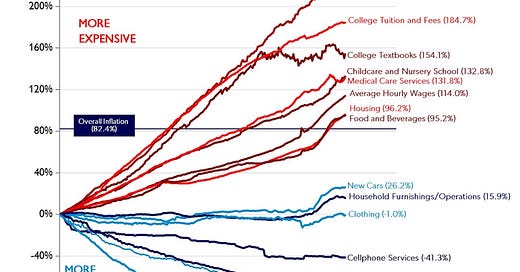Time Pricing Mark Perry's Chart of the Century
Since 2000 hospital services became 37.7 percent less abundant while TVs became 10,090 percent more abundant.
Professor Mark Perry publishes a chart illustrating the percentage change in the nominal prices of a variety of U.S. Consumer goods and services on a regular basis. He also notes the change in average hourly wages. His data comes from the Bureau of Labor Statistics (BLS). This is a great chart but note that prices can increase to infinity but can only decrease by 100 percent (then they become free).
We have compared each product to the change in average hourly wages to get the change in the time prices. The times prices are then compared over time to measure changes in abundance. This bar chart illustrates these changes.
Note that products and services that became less abundant are subject to high levels of government interference on both the demand and supply sides.
Also note that this chart does not include TVs. The time price of TVs decreased by over 99 percent. The time it took to earn the money to buy one TV in 2000, you get you 101.9 TVs today. TV abundance increased by 10,090 percent. The horizontal scale would be 12 times wider if we included TVs and everything else would look tiny.
Over this 23-year period overall inflation increased by 82.4 percent while average hourly income increased by 114 percent. Hourly income increased 38 percent faster than prices. This indicates a 14.8 percent decrease in overall time prices. You get 17.3 percent more today for the same amount of time 23 years ago.
This illustrates the fact that things can get more expensive and more affordable at the same time. At long as hourly wages are increasing faster than product prices, time price are decreasing, which is another way of saying personal abundance is increasing.
The iPhone is not included in this chart. In 2000 the iPhone was still seven years away. It is difficult to measure how much abundance this innovation has created. To get an idea, ask yourself how much someone would have to pay you to never use a mobile phone again. Yes you are a multi-millionaire.
Time prices are a better way to measure standards of living. To really understand our economy, we must move beyond thinking in dollars and cents, to thinking in hours and minutes. Time prices are the true prices.
We describe the process of transforming scarcities to abundances in our new book, Superabundance, available at Amazon. There has never been a better time to create more life.
Gale Pooley is a Senior Fellow at the Discovery Institute and a board member at Human Progress.







For TC Manning:
According to Market Scope the typical cost for LASIK surgery in 2023 was $4,492. This is up slightly from the 1998 price of $4,360. Unskilled hourly compensation in 1998 was around $7.75 versus $16.15 today. This would indicate that the time price has fallen 51.6 percent from 562.6 hours in 1998 to 272.1 hours today. You get 2.07 eyes corrected today for the time it took to earn the money to buy one in 1998.
It would be interesting to see the numbers for medical services not typically covered by insurance (like Lasik) to see if they have become more abundant over time.